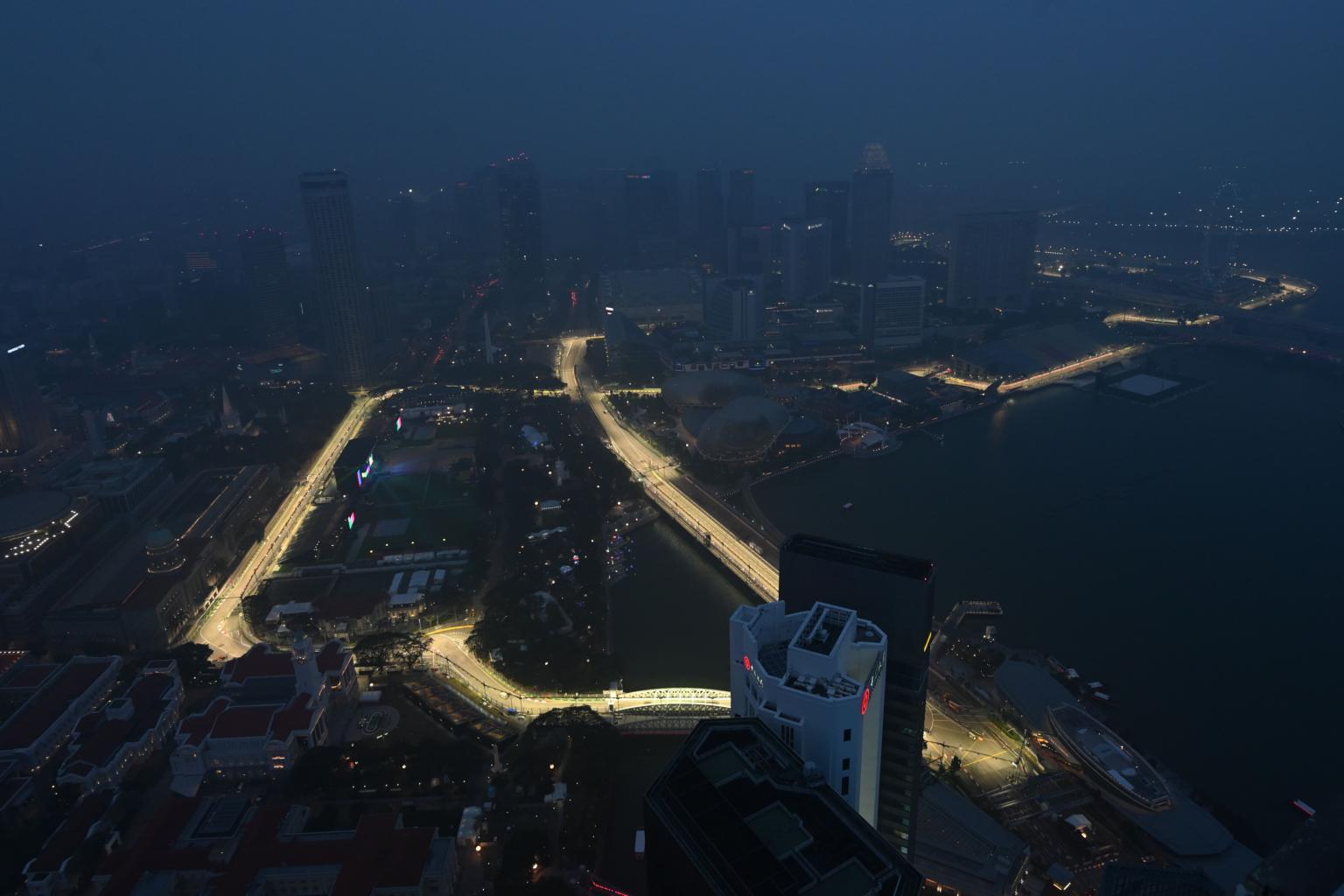F1 Singapore Grand Prix looks set to rev off to clear skies, but haze could still cloud the weekend
Sign up now: Get ST's newsletters delivered to your inbox

If winds blow from south Sumatra, the F1 race could take place under hazy skies, and the PSI could creep into the middle of the unhealthy range.
PHOTO: AFP
Follow topic:
SINGAPORE - The Formula 1 weekend looks set to rev off on Friday evening (Sept 20) under relatively clear skies, although hazy conditions could persist over the weekend, said the weatherman.
At 10am on Friday morning, the 24-hour Pollutant Standards Index (PSI), a measure of air quality here, was in the moderate range across Singapore.
Favourable winds had kept the pollution from forest fires in Indonesia at bay.
This is an improvement from the unhealthy air quality experienced here over the past week.
At a media briefing on Friday, the National Environment Agency (NEA) said it expects the 24-hour PSI over the next day to range between the high end of the moderate range and the low end of the unhealthy range.
The 1-hour PM2.5 readings are forecast to fluctuate between the normal and elevated bands.
At 10pm, the 24-hour PSI reading was 66-67 in the moderate range, while the 1-hour PM2.5 reading was 18-35 micrograms per cubic m in the normal band.
But in the coming days, the agency said dry weather is expected to persist over south Sumatra - the origin of most of the haze Singapore is experiencing.
If winds blow from that direction, the F1 race could take place under hazy skies, and the PSI could creep into the middle of the unhealthy range.
However, the NEA said showers are expected in south Sumatra at the end of the month, and this could provide some respite.
Throwback to 2015?
After years of clear skies, Singapore and the rest of South-east Asia are once again plagued by the scourge of haze.
In Singapore, government agencies, schools and companies have said they are ready to tackle the impact of the haze.
Schools have turned on air purifiers, while firms and organisations have distributed N95 masks to staff who work outdoors.
The situation is worse in Malaysia and Indonesia. There, schools have closed and flights grounded as the pollution blankets cities.
Changi Airport Group told The Straits Times that it is closely monitoring the current haze situation and has put in place measures to ensure the continuity of flight operations should the haze worsen.
The group is also working with airport partners and agencies on precautionary measures for the well-being of airport staff and to ensure that they are protected.
The measures include giving N95 masks and bottled water to airport staff working outdoors in the airside, and deferring or cutting non-essential outdoor work such as horticulture work.
The group will also display notices and health advisories regarding PSI levels for airport staff working outdoors and passengers, and advise drivers in the airfield to switch on vehicle headlights during the day and to be more careful.
Still, the haze situation is not yet as bad as that in 2015, when the region suffered its worst haze episode on record.
That year, a climate phenomenon known as El Nino had caused hotter and drier weather in South-east Asia, which worsened the forest fires in Indonesia and caused them to spiral out of control.
El Nino conditions are not present this year in this part of the world, although the region is also experiencing hotter and drier weather than usual.
This is due to a persistent cooling of sea surface temperatures in the eastern Indian Ocean, off the west coast of Sumatra, which hinders the formation of rain clouds.
However, it is not clear yet if this year's haze episode would be as bad as the 2015 crisis, the NEA said.
The fire season had started earlier that year, and there were also more hot spots detected then, compared to current observations.
However, this year's fire season is not yet over. Determining whether the haze this year could be as bad as 2015 depends on multiple factors, including weather, and the persistence of forest fires, the NEA said.
Clearing the air over air quality readings
During Friday's briefing, the NEA also cleared up some misconceptions over how it tabulates the 24-hour PSI.
As air pollution descended on Singapore over the past week, many had questioned whether the figures on the NEA's website have downplayed the severity of the haze.
Instead of relying on readings provided by the NEA, some turned to other air quality readings, such as the World Air Quality Index (AQI), which is compiled by a non-profit organisation headquartered in Beijing based on measurements provided by affected countries.
The NEA has since clarified that there are no international guidelines on how air quality indices should be computed.
"Countries adopt different index systems based on their local needs and circumstances," said a spokesman.
This includes considerations such as how urban the setting is, and what the surrounding industries are like.
This is important, as it takes into consideration the baseline air quality - or air quality during periods with no haze.
As this baseline differs from city to city, no two air quality indices are alike, the NEA clarified.
The NEA provides two air quality readings - the 24-hour PSI, and the one-hour PM2.5 readings.
Both serve different functions.
The one-hour PM2.5 measures the average hourly concentration of PM2.5 particles - the dominant pollutant during haze episodes - and is meant to help people gauge immediate activities, such as whether going for a jog is the best option now.
However, forecasts of the 24-hour PSI should be relied on when planning future activities, such as whether one should go for a picnic the next day.
The NEA said this forecast is made based on current haze situation, as well its predictions on weather variables, such as wind direction or if rain is expected.

